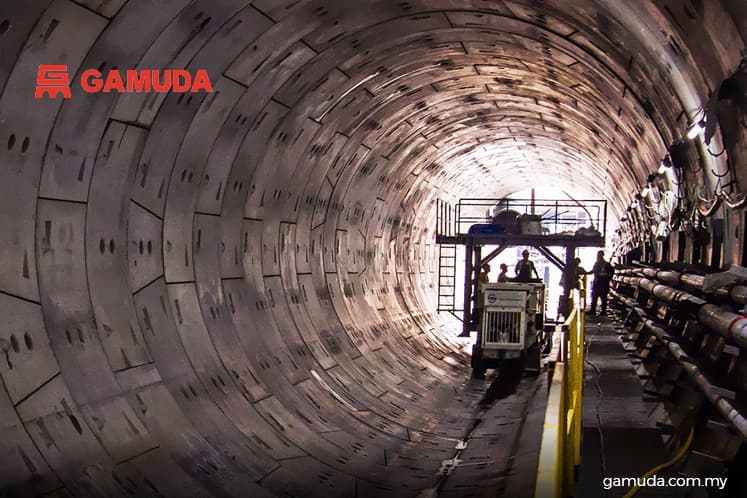
This article first appeared in The Edge Financial Daily on June 25, 2019
Gamuda Bhd
(June 24, RM3.57)
Maintain underweight with a higher fair value (FV) of RM2.64: We cut our financial years 2020 and 2021 forecast (FY20-FY21F) net profit by 20% and 34% respectively but raised our FV by 18% to RM2.64 from RM2.23, as we changed our valuation method to sum-of-parts (SoP) from straight price-earnings (P/E) to better reflect the monetisation of Gamuda Bhd’s water and toll road assets. Our valuation basis for Gamuda’s construction business, within the SoP valuation, remains unchanged at 10 times forward earnings, in line with our benchmark forward target P/E of 10 times for large-cap construction stocks.
Having made known in February 2019 about its intention to acquire all of Gamuda’s toll road assets — Lebuhraya Damansara Puchong (LDP), Sistem Penyuraian Trafik KL Barat (SPRINT), Lebuhraya Shah Alam (Kesas) and SMART Tunnel — the government has finally announced its offer prices for them. To recap, Gamuda’s stakes in the toll road assets are an effective 43.6% stake in the LDP via its 43.6% stake in Lingkaran Trans Kota Holdings Bhd (Litrak) (LDP is wholly owned by Litrak); an effective 51.8% stake in SPRINT by virtue of a 30% direct stake and a 21.8% indirect stake via Litrak which owns a 50% stake in SPRINT; a 70% direct stake in Kesas; and a 50% direct stake in SMART.
In equity value, that is net of debts in their entirety, the offer values the LDP, Kesas, SPRINT and SMART at RM2.34 billion, RM1.23 billion, RM870 million and RM60 million respectively. Compared with our discounted cash flow-based valuations, we believe Gamuda is getting a good deal for the LDP, Kesas and SMART, but less so for SPRINT. All in at RM2.36 billion, the price is at a 3% premium to our valuation of RM2.3 billion based on a 6% discount.
We believe Gamuda will most likely accept the offer. We take comfort that the government had adhered to the sanctity of contract in the deal versus the “hardline” stance narratives such as invoking appropriation clauses previously. We believe this market-friendly approach will reduce the policy risk, and hence the market-risk premium as a whole. The disposal’s proceeds of RM2.36 billion would reduce Gamuda’s net debt and gearing of RM3.4 billion and 0.44 times, adjusted for proceeds of RM1.02 billion from the recently concluded disposal of its 40% stake in SPLASH, to RM1.1 billion and 0.14 times respectively.
We cut our FY20–FY21F net profit by 20% and 34% respectively as we expect contributions from the toll road assets to halve in FY20F and completely removed in FY21F, partially mitigated by interest savings from the disposal’s proceeds. Realistically, it will take some time for Gamuda to identify new businesses to fill the vacuum. The market has high expectations of the massive Penang Transport Master Plan (PTMP) in which Gamuda is in the driver’s seat via its 60% stake in the consortium appointed as the project delivery partner.
While the PTMP project appears viable — the three man-made islands under the Penang South Reclamation could be sold for RM70 billion, more than enough to fund the RM46 billion reclamation cost and public infrastructure spending under the PTMP project — its implementation, however, will be very challenging from a cash flow perspective, apart from the state government’s political will on strong objections by environmentalists. The PTMP project will incur a tremendous upfront cash flow to fund the reclamation and the construction of public infrastructure, only to be recouped many years later via sale of land on the man-made islands. We believe this could only be possible with substantial soft loans from the federal government or international development banks.
We acknowledged the East Coast Rail Link (ECRL) and Bandar Malaysia projects’ revival shall result in more jobs available for local construction players. However, we believe the market has not priced in enough risk premium to reflect the latest megaprojects being driven by Chinese funding and world-class Chinese contractors, probably leaving local contractors with low-value or margin supporting roles for the projects; and that given the still elevated national debt, the government has no choice but to remain steadfastly committed to fiscal prudence, meaning the ECRL project’s revival could be a “zero-sum game” as it impedes the government’s ability to implement other public infrastructure projects. We believe construction stocks’ valuations, including Gamuda’s, have run ahead of their fundamentals amid this euphoria. — AmInvestment Bank, June 24